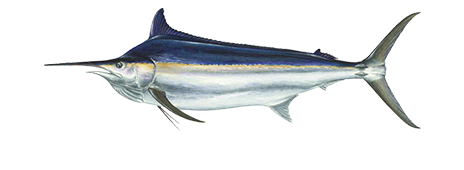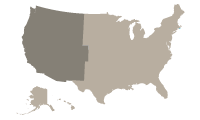
Black Marlin
A highly rated game fish, the black marlin has the power, size, and persistence of which anglers dream.

Region
West
Catch ease
Hard
Habitat
Ocean
How to identify a Black Marlin
It can be quickly and positively identified since it is the only marlin that has rigid pectoral fins that cannot be folded flat up against the body without breaking the joints. It is also set apart by the airfoil shape of the pectoral fins and by its very short ventral fins, which almost never exceed 12 in (30 cm) in length, regardless of the size of the fish. The first dorsal fin is proportionately the lowest of any billfish, usually less than 50 percent of the body depth. The body is laterally compressed rather than rounded, much more so than in similar sized blue marlin. The body is slate blue dorsally, changing abruptly to silvery white below the lateral line. When feeding or leaping, the black marlin may display light blue vertical stripes on the sides (see striped marlin coloration). Slight variations in color cause some specimens to have a silvery haze over the body. In Hawaii this has led to the name silver marlin (once thought to be a separate species).
Where to catch Black Marlin
The black marlin occurs in the tropical Indian and Pacific oceans. In tropical areas distribution is scattered but continuous in open waters, denser near coastal areas and islands. In temperate waters occurrence is rare. A few stray black marlin travel around the Cape of Good Hope into the Atlantic. Some have been known to cross the ocean from there, traveling in a southwesterly direction as far as the Atlantic coasts of the Lesser Antilles. Such excursions are, however, regarded as exceptional. Little is known of the migrations of this pelagic species, but they do not appear to be extensive except in unusual cases. The following list includes additional details on where to catch this fish:
How to catch Black Marlin
Its diet consists of squid and pelagic fishes. Fishing methods include trolling with large, whole baits (mackerel, bonito, flying fish, squid and others) or with artificial lures. Live bait is also effective. The following are fishing methods used to catch this fish:
Black Marlin lures, tackle & bait
The following are lures, tackle or bait that can be used to catch this fish:
